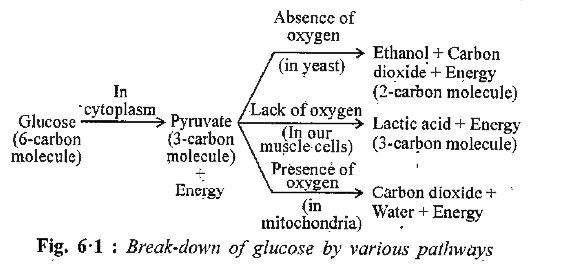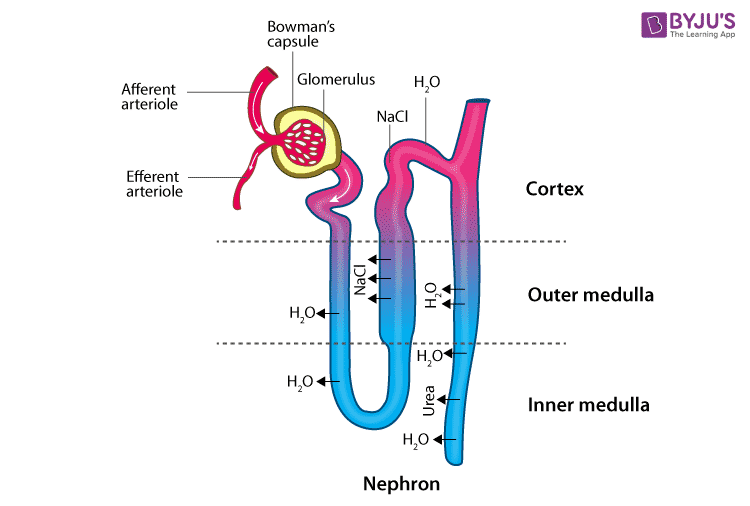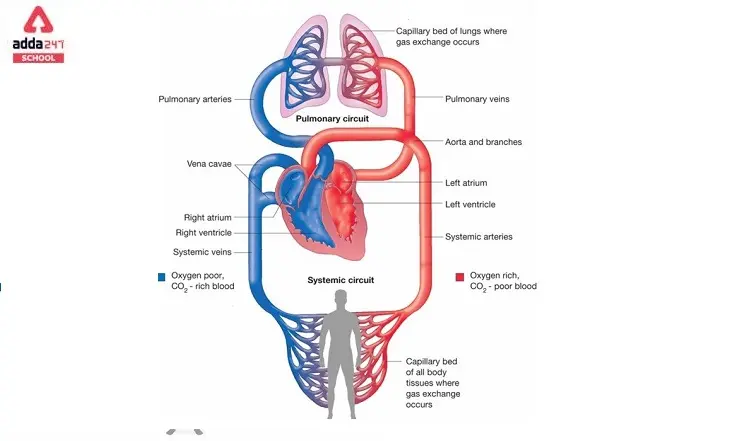Class 10 Science Chapter 6 Solution
Questions Page Number 95
1. Why is diffusion insufficient to meet the oxygen requirements of multicellular organisms like humans?
Solution:
Multicellular organisms like humans have large bodies and need a lot of oxygen to survive. Diffusion is a slow process and cannot quickly transport oxygen to all body cells. Because of this, diffusion alone is not enough to meet the oxygen needs of humans.
2. What criteria do we use to decide whether something is alive?
Solution:
Things like walking, breathing, and growing help us tell if something is alive. But some living things show changes that we can’t see with our eyes. So, the most important way to decide if something is alive is by checking if it has life processes happening inside.
3. What are outside raw materials used for by an organism?
Solution:
Living things need raw materials from their surroundings to stay alive. They use things like food and oxygen to grow, get energy, and survive. The type of raw materials needed depends on how complex the organism is and where it lives.
4. What processes would you consider essential for maintaining life?
Solution:
The important processes that help in maintaining life are:
– Respiration – To get energy from food.
– Digestion – To break down food for nutrients.
– Excretion – To remove waste from the body.
– Circulation – To transport oxygen and nutrients in the body.
– Transportation – To move important substances within the body.
Questions Page Number 101
1. What are the differences between autotrophic nutrition and heterotrophic nutrition?
Solution:
1. Autotrophic nutrition involves the synthesis of food by the organism itself using simple substances,
whereas heterotrophic nutrition involves obtaining food from other organisms.
2. Organisms with autotrophic nutrition can prepare their own food through photosynthesis or chemosynthesis,
whereas organisms with heterotrophic nutrition depend on plants or other animals for food.
3. Green plants, algae, and some bacteria show autotrophic nutrition,
whereas animals, fungi, and most bacteria show heterotrophic nutrition.
4. Autotrophs use sunlight, carbon dioxide, and water to produce glucose,
whereas heterotrophs consume already prepared organic substances.
5. Autotrophic nutrition is the primary source of energy for all life on Earth,
whereas heterotrophic nutrition depends on the energy provided by autotrophs.
6. Autotrophs have chlorophyll to capture sunlight,
whereas heterotrophs do not have chlorophyll.
7. In autotrophic nutrition, food is prepared inside the body,
whereas in heterotrophic nutrition, food is ingested from external sources.
2. Where do plants get each of the raw materials required for photosynthesis?
Solution:
Plants need these raw materials for photosynthesis:
1. Carbon dioxide (CO2): Taken from the air through stomata (tiny pores on leaves).
2. Water: Absorbed by the roots from the soil.
3. Sunlight: Captured by leaves to provide energy.
4. Nutrients: Collected from the soil through roots.
3. What is the role of the acid in our stomach?
Solution:
The hydrochloric acid (HCl) in our stomach helps in:
1. Breaking down food: It dissolves food for easier digestion.
2. Activating enzymes: It turns pepsinogen into pepsin, which helps digest proteins.
3. Killing germs: It destroys harmful bacteria and protects us from infections.
4. What is the function of digestive enzymes?
Solution:
Digestive enzymes break down complex food into simple forms, making it easier for the body to absorb nutrients. These nutrients are then carried by the blood to all parts of the body.
5. How is the small intestine designed to absorb digested food?
Solution:
The small intestine has tiny finger-like projections called villi and microvilli. These increase the surface area, making food absorption more efficient. The villi contain blood vessels that absorb nutrients and carry them to the bloodstream, which then transports the nutrients to all parts of the body.
Questions Page Number 105
1. What advantage over an aquatic organism does a terrestrial organism have with regard to obtaining oxygen for respiration?
Solution:
Terrestrial organisms breathe atmospheric oxygen, while aquatic organisms get oxygen dissolved in water. Since there is more oxygen in the air than in water, terrestrial organisms do not need to breathe quickly to get enough oxygen. In contrast, aquatic organisms must breathe faster to meet their oxygen needs.
2. What are the different ways in which glucose is oxidised to provide energy in various organisms?
Solution:
In all organisms, glucose is first broken down in the cytoplasm into two 3-carbon compounds called pyruvate. This process is known as glycolysis. After this, the further breakdown of pyruvate happens in different ways depending on the organism.

3. How are oxygen and carbon dioxide transported in human beings?
Solution:
In humans, oxygen and carbon dioxide are carried by the bloodstream. Oxygen is delivered to the cells, while carbon dioxide is taken away from the cells. The exchange of gases happens in the alveoli (tiny air sacs) of the lungs and the blood capillaries around them.
– Oxygen moves from the alveoli to the blood by diffusion.
– Carbon dioxide moves from the blood to the alveoli by diffusion.
4. How are the lungs designed in human beings to maximise the area for the exchange of gases?
Solution:
1. Branching Structure: Inside the lungs, air passages divide into smaller tubes that end in tiny balloon-like sacs called alveoli.
2. Large Surface Area: Alveoli provide a large surface for the exchange of oxygen and carbon dioxide. Their walls have a network of blood vessels to help with gas transfer.
3. Breathing Process: When we breathe in, our ribs lift, and the diaphragm flattens, which makes the chest cavity bigger and pulls air into the lungs.
4. Gas Exchange: The blood carries carbon dioxide from the body to the alveoli and takes in oxygen from the alveoli to deliver it to all body cells.
5. Residual Air: After exhaling, some air remains in the lungs to allow continuous gas exchange.
Questions Page Number 110
1. What are the components of the transport system in human beings? What are the functions of these components?
Solution:
Components of the Transport System in Humans and Their Functions
1. Heart:
– Pumps blood to all parts of the body.
– Sends oxygen-rich blood to the body and collects impure blood to send to the lungs for oxygen.
2. Blood:
– Carries oxygen, nutrients, carbon dioxide, and waste materials.
3. Blood Vessels:
– Arteries and veins transport blood throughout the body.
2. Why is it necessary to separate oxygenated and deoxygenated blood in mammals and birds?
solution:
Mammals and birds are warm-blooded animals, meaning they keep their body temperature constant no matter the environment. This requires more oxygen for cellular respiration to produce enough energy to maintain their body temperature. Separating oxygenated and deoxygenated blood makes their circulatory system more efficient.
3. What are the components of the transport system in highly organised plants?
Solution:
Highly organised plants have two main conducting tissues for transportation:
1 .Xylem – Carries water and minerals from the roots to the rest of the plant.
2. Phloem – Transports food from the leaves to other parts of the plant.
4. How are water and minerals transported in plants?
Solution:
In plants, xylem helps move water and minerals from the roots to other parts of the plant:
1?? Xylem Channels – Tracheids and vessels in the roots, stems, and leaves are connected to form continuous water-conducting pathways.
2?? Transpiration Pull – Water evaporates from the leaves, creating a suction pressure that pulls water up from the roots.
3?? Continuous Flow – This process keeps water moving steadily from roots to other parts of the plant.
5. How is food transported in plants?
Solution:
Plants use a special tissue called phloem to transport food from the leaves to other parts of the plant.
1?? Phloem Function – It carries food (like sucrose) to different parts of the plant.
2?? Energy Use – This process needs energy from ATP to work.
3?? Osmotic Pressure – ATP increases osmotic pressure, causing water to move.
4?? Food Movement – The pressure difference moves food from areas of high pressure (leaves) to low pressure (other parts).
Questions Page Number 112
1. Describe the structure and functioning of nephrons.
Solution:
Structure and Functioning of Nephrons
Nephrons are the filtering units of the kidneys, and there are many nephrons in each kidney. They filter blood and form urine by reabsorbing important substances like glucose, amino acids, salts, and water.
Main Parts of a Nephron
1?? Glomerulus – A cluster of tiny blood vessels that filter waste.
2?? Bowman’s Capsule – A cup-shaped structure that collects the filtered liquid.
3?? Long Renal Tube – A tube where reabsorption and urine formation occur.

How Nephrons Work
1. Blood Entry – Blood enters the kidneys through the renal artery, which divides into tiny capillaries around the glomerulus.
2. Filtration – Water and small substances like glucose and salts pass into Bowman’s capsule.
3. Reabsorption – In the proximal tubule, useful substances are reabsorbed into the blood, while unwanted ones are added to the urine.
4. Water Absorption – In the loop of Henle, more water is absorbed.
5. Urine Collection – The remaining liquid goes through the distal tubule into the collecting duct, which gathers urine from many nephrons.
6. Urine Transport – Urine flows from the collecting duct to the ureter, then to the bladder, and finally leaves the body through the urethra.
2. What are the methods used by plants to get rid of excretory products?
Solution:
Methods Used by Plants to Remove Waste
1?? Transpiration – Plants remove extra water by releasing it as water vapor through tiny pores called stomata.
2?? Storage in Dead Cells – Some waste is stored in dead tissues or falling leaves, which are later shed.
3?? Cellular Vacuoles – Unwanted substances are stored inside vacuoles (storage sacs) within the plant cells.
4?? Resins and Gums – Plants store waste like resins and gums in old xylem (wood).
5?? Excretion into Soil – Some waste products are released into the soil through the roots.
3. How is the amount of urine produced regulated?
Solution:
1?? Excess Water and Waste – More urine is produced if there is extra water or waste in the body.
2?? Environment – Weather conditions (like heat or cold) also affect urine production.
3?? ADH Hormone – A hormone called ADH (Anti-Diuretic Hormone) controls how much water the body keeps or releases, adjusting urine production.
Questions Page Number 113
1. The kidneys in human beings are a part of the system for
(a) nutrition
(b) respiration
(c) excretion
(d) transportation
Solution:
The Kidneys in Humans are Part of Which System?
? Answer: (c) Excretion
The excretory system in humans includes:
– 2 Kidneys – Filter waste from the blood.
– 2 Ureters – Carry urine from the kidneys to the bladder.
– Urinary Bladder – Stores urine temporarily.
– Urethra – Releases urine out of the body.
2. The xylem in plants is responsible for
(a) transport of water
(b) transport of food
(c) transport of amino acids
(d) transport of oxygen
Solution:
In plants, Xylem is responsible for the transport of water. so, the answer is (a)
3. The autotrophic mode of nutrition requires
(a) carbon dioxide and water
(b) chlorophyll
(c) sunlight
(d) all of the above
Solution:
The autotrophic mode of nutrition requires carbon dioxide, water, chlorophyll and sunlight from the preparation of food. so, the answer is (d)
4. The breakdown of pyruvate to give carbon dioxide, water, and energy takes place in
(a) cytoplasm.
(b) mitochondria
(c) chloroplast
(d) nucleus
Solution:
The breakdown of pyruvate to give carbon dioxide, water and energy take place in mitochondria. so, the answer is (b)
5. How are fats digested in our bodies? Where does this process take place?
Solution: Fat digestion takes place in the small intestine. This is where the digestion of carbohydrates, fats, and proteins is completed.
– How are fats digested?
1. Bile juice from the liver makes the acidic food from the stomach alkaline for enzymes to work.
2. Bile salts break large fat globules into smaller ones, making it easier for enzymes to act.
3. The pancreas releases lipase, an enzyme that breaks down fats into fatty acids and glycerol.
4. The intestinal juice helps convert proteins to amino acids, carbohydrates to glucose, and fats to fatty acids and glycerol for easy absorption.
6. What is the role of saliva in the digestion of food?
Solution: The food we eat is complex and needs to be broken down into smaller molecules for easy absorption.
1. Saliva contains an enzyme called salivary amylase, which helps break down starch (a complex carbohydrate) into sugar.
2. While chewing, saliva mixes with food and helps in its smooth movement in the mouth.
3. The muscular tongue helps in mixing food with saliva properly.
Thus, saliva plays a key role in food digestion and absorption.
7. What are the necessary conditions for autotrophic nutrition, and what are its byproducts?
Solution: Autotrophic nutrition is the process where plants make their own food using sunlight, carbon dioxide, and water through photosynthesis.
1. Plants absorb carbon dioxide from the air and water from the soil.
2. In the presence of sunlight and chlorophyll, these are converted into carbohydrates (sugar).
– Carbohydrates provide energy to the plant.
– Extra carbohydrates are stored as starch and used later when the plant needs energy.
The main byproduct of this process is oxygen, which is released into the air.
8. What are the differences between aerobic and anaerobic respiration? Name some organisms that use the anaerobic mode of respiration.
Solution:
Aerobic Respiration:
– Happens with oxygen.
– Produces carbon dioxide (CO2), water, and a lot of energy.
– The first step occurs in the cytoplasm, and the next step happens in the mitochondria.
– Complete breakdown of glucose takes place.
– Occurs in humans, animals, and plants (higher organisms).
Anaerobic Respiration:
– Happens without oxygen.
– Produces ethyl alcohol (or lactic acid), carbon dioxide (CO2), and less energy.
– The first step happens in the cytoplasm, and the next step happens in the mitochondria.
– Incomplete breakdown of glucose occurs.
– Happens in yeast, some bacteria, and parasites like tapeworms (lower organisms).
9. How are the alveoli designed to maximise the exchange of gases?
Solution:
– The lungs have tiny balloon-like structures called alveoli, which help in gas exchange.
– Inside the lungs, air passages divide into smaller tubes, leading to the alveoli.
– The alveoli have thin walls and a network of blood vessels, making gas exchange easier.
– When we breathe in, our ribs lift and the diaphragm flattens, creating more space in the chest for air to fill the alveoli.
– Oxygen from the alveoli moves into the blood, and carbon dioxide from the blood moves into the alveoli to be exhaled.
– Even after exhaling, some air remains in the lungs, ensuring a constant supply of oxygen.
10. What would be the consequences of a deficiency of haemoglobin in our bodies?
Solution:
Haemoglobin is a protein that carries oxygen to the body’s cells for energy. If there is not enough haemoglobin, red blood cells (RBCs) cannot carry enough oxygen. This causes a lack of oxygen in the body. A haemoglobin deficiency can lead to a condition called anaemia.
11. Describe the double circulation of blood in human beings. Why is it necessary?
Solution:
Simple Explanation:
Double circulation means that in one complete cycle, blood passes through the heart twice. This helps keep oxygen-rich and oxygen-poor blood separate, which is important for maintaining a constant body temperature.
The double circulation system includes:
1. Pulmonary circulation – The right ventricle pumps oxygen-poor blood to the lungs, where it gets oxygen. The oxygen-rich blood then returns to the left atrium and moves to the left ventricle, which pumps it into the aorta for body circulation.
2. Systemic circulation – The left ventricle pumps oxygen-rich blood to the entire body. The oxygen-poor blood returns to the right atrium through the vena cava, and the cycle repeats.

Looking for reliable and accurate Class 10 Science solutions? Our website provides complete NCERT Class 10 Science solutions for all chapters, fully solved and explained in simple language. Whether it’s Physics, Chemistry, or Biology, we cover every topic from chemical reactions and equations, acids, bases and salts, life processes, to light reflection and refraction, and more. These solutions are designed to help students understand concepts clearly and prepare effectively for board exams. All answers follow the latest CBSE syllabus and marking scheme, making it the perfect resource for students, teachers, and parents. Access free, chapter-wise Science Class 10 solutions now and boost your exam preparation with confidence!